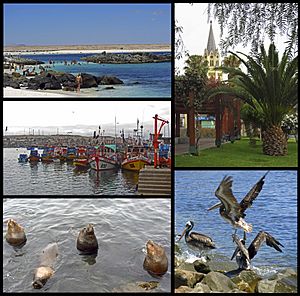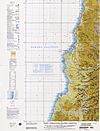Caldera, Chile facts for kids
Quick facts for kids
Caldera
|
|||||
|---|---|---|---|---|---|

Port of Caldera
|
|||||
|
|||||
| Country | |||||
| Region | |||||
| Province | Copiapó Province | ||||
| Government | |||||
| • Type | Municipality | ||||
| Area | |||||
| • Total | 4,666.6 km2 (1,801.8 sq mi) | ||||
| Elevation | 44 m (144 ft) | ||||
| Population
(2012 Census)
|
|||||
| • Total | 16,150 | ||||
| • Density | 3.4608/km2 (8.9633/sq mi) | ||||
| • Urban | 13,540 | ||||
| • Rural | 194 | ||||
| Sex | |||||
| • Men | 7,237 | ||||
| • Women | 6,497 | ||||
| Time zone | UTC−4 (CLT) | ||||
| • Summer (DST) | UTC−3 (CLST) | ||||
| Area code(s) | +56 52 | ||||
| Website | Municipality of Caldera (in Spanish) | ||||
Caldera is a port city and commune located in northern Chile. It's part of the Copiapó Province in the Atacama Region. Caldera has a safe harbor protected by special walls called breakwaters. It serves as the main port for the important mining area around Copiapó. These two places are connected by Chile's very first railroad!
Contents
Geography and Climate
Caldera is about 75 kilometers (47 miles) west of Copiapó, right on the Pacific Ocean. The weather here is usually warm and very dry. This is because it's located on the coast of the Atacama Desert. However, cool ocean currents from the sea help keep the temperatures from getting too hot. Lately, the climate has become a bit colder due to global climate change. The entire commune of Caldera covers a large area of about 4,667 square kilometers (1,802 square miles).
| Climate data for Caldera | |||||||||||||
|---|---|---|---|---|---|---|---|---|---|---|---|---|---|
| Month | Jan | Feb | Mar | Apr | May | Jun | Jul | Aug | Sep | Oct | Nov | Dec | Year |
| Mean daily maximum °C (°F) | 23.3 (73.9) |
23.5 (74.3) |
22.1 (71.8) |
20.0 (68.0) |
18.3 (64.9) |
17.0 (62.6) |
16.5 (61.7) |
16.8 (62.2) |
17.5 (63.5) |
18.7 (65.7) |
20.3 (68.5) |
21.9 (71.4) |
19.7 (67.4) |
| Daily mean °C (°F) | 19.7 (67.5) |
19.7 (67.5) |
18.5 (65.3) |
16.6 (61.9) |
14.9 (58.8) |
13.3 (55.9) |
13.0 (55.4) |
13.2 (55.8) |
14.0 (57.2) |
15.1 (59.2) |
16.8 (62.2) |
18.4 (65.1) |
16.1 (61.0) |
| Mean daily minimum °C (°F) | 16.2 (61.2) |
16.3 (61.3) |
15.2 (59.4) |
13.6 (56.5) |
11.9 (53.4) |
10.0 (50.0) |
9.8 (49.6) |
10.0 (50.0) |
10.8 (51.4) |
12.0 (53.6) |
13.4 (56.1) |
15.0 (59.0) |
12.9 (55.1) |
| Average precipitation mm (inches) | 0.1 (0.00) |
0.0 (0.0) |
0.0 (0.0) |
1.2 (0.05) |
3.6 (0.14) |
8.2 (0.32) |
5.6 (0.22) |
3.7 (0.15) |
0.9 (0.04) |
1.3 (0.05) |
0.8 (0.03) |
0.4 (0.02) |
25.8 (1.02) |
| Average relative humidity (%) | 76 | 77 | 79 | 80 | 82 | 82 | 82 | 81 | 81 | 80 | 78 | 77 | 80 |
| Source: Bioclimatografia de Chile | |||||||||||||
History of Caldera
In 1687, an English explorer named Edward Davis visited the area near Caldera. Later, in 1840, William Wheelwright suggested building a railway. This led to the creation of Chile's very first railway line in 1851, connecting Caldera to Copiapó. It officially opened on Christmas Day in 1851. Caldera quickly became an important port for shipping out valuable minerals. The city of Caldera was officially founded on September 23, 1850.
Caldera has faced natural disasters like earthquakes and tsunamis many times. Some of the biggest ones happened in 1868, 1877, and 1922. During the 1891 Chilean Civil War, a naval battle took place in Caldera Bay. In this battle, small, fast boats loyal to the government sank a large rebel ship called the Blanco Encalada.
People of Caldera
In 1903, about 2,130 people lived in Caldera. According to a census in 2002, Caldera had 13,734 residents. This included 7,237 men and 6,497 women. Most of these people (98.6%) lived in the city, while a smaller number (1.4%) lived in rural areas. The population of Caldera grew by 13.9% between 1992 and 2002.
Fun Places to Visit in Caldera
Caldera has many interesting places to explore, both in the city and nearby!
City Attractions
- Old Railway Station: This was Chile's first railway station, built in 1850. It was designed to protect valuable minerals brought by train from Chañarcillo. The building was very long and wide, covering a whole train!
- San Vicente de Paul Church: Built in 1862, this church has a beautiful Gothic wooden tower. Inside, you can see a special statue of the Virgin of Sorrows. It was brought from Peru after the War of the Pacific.
- Cave of Padre Negro: This is a special place for visitors, built into a rock by a Colombian priest named Crisógono Sierra y Velásquez. People called him Padre Negro (Black Father). Inside, you can see colorful murals painted by Luis Enrique Cerda.
- Caldera Municipal Cemetery: This was the first non-religious cemetery in Chile, opened in 1876. In its old section, you can find impressive tombs and monuments made with iron from England and marble from Italy.
- Tornini House Museum: This is a private museum that opened in 2010. It shows old items from Caldera's history, including things from a revolution in 1859, the War of the Pacific, and the arrival of Italian families in the late 1800s. The house itself is old and was once owned by important people, including a British Consul.
Nearby Nature Spots
- Orbicular Granite Nature Sanctuary: About 11 kilometers (7 miles) north of Caldera, you'll find this amazing natural wonder. It's a small area with rocks that have cool circular patterns on them. Because it's so unique, it was made a nature sanctuary in 1981 to protect it.
- Bahía Inglesa: Just 6 kilometers (4 miles) from Caldera, this popular beach resort means "English Bay." It got its name from the English explorer Edward Davis who visited here. Bahía Inglesa is famous for its soft white sands and warm waters. It has places to camp, hotels, and restaurants, making it great for visitors. There's even an underwater museum in the bay!
- Playa La Virgen: This beach is about 35 kilometers (22 miles) south of Bahía Inglesa. Many people consider it the best beach in Chile because of its beautiful white sand and warm water. Its name, "Virgin Beach," comes from a rock nearby that looks like the Virgin Mary. You can camp here, park your car, and find restaurants close by.
Caldera's Economy
The main ways people make a living in Caldera are through mining copper ore and growing citrus fruits. These fruits are then shipped out from the port. Fishing and tourism are also very important for the local economy. The beautiful beaches bring many visitors to the area.
How Caldera is Governed
Caldera is a commune, which is a type of local government area in Chile. It's managed by a council and led by a mayor, called an alcalde. The mayor is chosen by the people in an election every four years. Since 2016, the mayor of Caldera has been Brunilda González.
Caldera is also part of larger government groups. For example, it's in an electoral district that chooses representatives for the Chamber of Deputies, which is part of Chile's national government. It's also part of a senatorial area that elects members to the Senate.
Gallery
Sister Cities
Caldera has special connections with these cities:
 Lules, Argentina
Lules, Argentina Villa Unión, Argentina
Villa Unión, Argentina General Lamadrid, Argentina
General Lamadrid, Argentina
See also
 In Spanish: Caldera (Chile) para niños
In Spanish: Caldera (Chile) para niños











